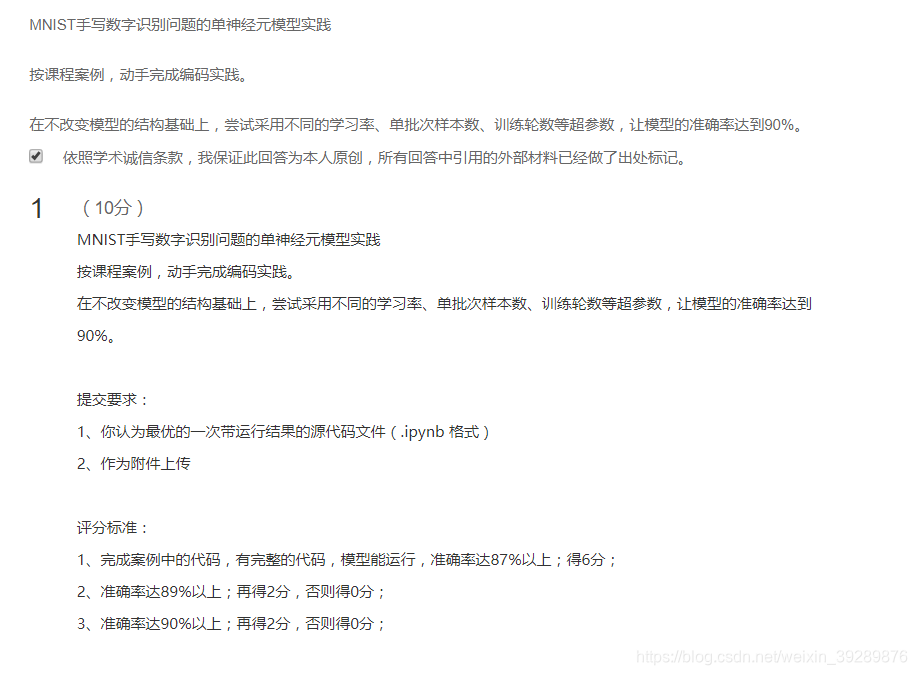具体代码见github
1问题

2代码实践
2.1载入数据
import tensorflow as tf
import tensorflow.examples.tutorials.mnist.input_data as input_data
mnist=input_data.read_data_sets("MNIST/",one_hot=True)
可以下载完数据集放入MNIST文件下,如果用tensorflow自己的方法下载较慢
print("训练集数量:",mnist.train.num_examples,',验证集数量:',mnist.validation.num_examples,',测试集数量:',mnist.test.num_examples)

2.2模型变量
定义x和y的占位符
# mnist中每张图片共有28*28=784个像素点
x=tf.placeholder(tf.float32,[None,784],name="X")
# 0-9一共10个数字--10个类别
y=tf.placeholder(tf.float32,[None,10],name="Y")
创建变量
W=tf.Variable(tf.random_normal([784,10]),name='W')
b=tf.Variable(tf.zeros([10]),name="b")
单个神经元构建神经网络
forward=tf.matmul(x,W)+b# 向前计算
关于softmax regression 当我们处理多分类任务时,通常需要使用softmax regression模型 softmax会为每一类估算出一个概率 工作原理:当判定为某一的特征相加,然后把这些特征转化为判定是这一类的概率
pred=tf.nn.softmax(forward)
2.3训练模型超参数
train_epochs=100
batch_size=50
total_batch=int(mnist.train.num_examples/batch_size)
display_step=1
learning_rate=0.02
2.4定义模型
定义损失函数
# 定义交叉熵损失函数
loss_function=tf.reduce_mean(-tf.reduce_sum(y*tf.log(pred),reduction_indices=1))
定义优化器
#梯度下降优化器
optimizer=tf.train.GradientDescentOptimizer(learning_rate).minimize(loss_function)
定义准确率
# 检查预测类别tf.argmax(pred,1)与实际类别tf.argmax(y,1)的匹配情况
correct_prediction=tf.equal(tf.argmax(pred,1),tf.argmax(y,1))
# 准确率,将布尔值转化为浮点数,并计算平均值
accuracy=tf.reduce_mean(tf.cast(correct_prediction,tf.float32))
sess=tf.Session()
init=tf.global_variables_initializer()
sess.run(init)
2.5模型训练
# 开始训练
for epoch in range(train_epochs):
for batch in range(total_batch):
xs,ys=mnist.train.next_batch(batch_size)#读取数据
sess.run(optimizer,feed_dict={x:xs,y:ys})# 执行批次训练
# total_batch个批次训练完成后,使用验证数据计算误差和准确率;验证集没有分批
loss,acc=sess.run([loss_function,accuracy],feed_dict={x:mnist.validation.images,y:mnist.validation.labels})
#打印训练过程中信息
if(epoch+1)%display_step==0:
print("Train Epoch:","%02d"%(epoch+1),"Loss=","{:.9f}".format(loss),\
'Accuracy=',"{:4f}".format(acc))
print("Train Finished")

3评估模型
accu_test=sess.run(accuracy,feed_dict={x:mnist.test.images,y:mnist.test.labels})
print("test accuracy:",accu_test)

accu_train=sess.run(accuracy,feed_dict={x:mnist.train.images,y:mnist.train.labels})
print("test accuracy:",accu_test)

accu_validation=sess.run(accuracy,feed_dict={x:mnist.validation.images,y:mnist.validation.labels})
print("test accuracy:",accu_validation)

4应用模型
#由于pred预测结果是0ne-hot编码格式,所以转换为0-9的数字
prediction_result=sess.run(tf.argmax(pred,1),feed_dict={x:mnist.test.images})
# 查看结果
prediction_result[0:10]

定义可视化函数
import matplotlib.pyplot as plt
import numpy as np
def plot_images_labels_prediction(images, #图像列表
labels, # 标签列表
prediction, # 预测值列表
index, #从第index个开始显示
num=10): # 缺省一次显示10幅
fig=plt.gcf() # 获取当前图标
fig.set_size_inches(10,12)# 1英寸等于2.54cm
if num >25: # 最多显示25个图
num=25
for i in range(0,num):
ax=plt.subplot(5,5,i+1)#获取当前要处理的子图
ax.imshow(np.reshape(images[index],(28,28)),cmap='binary')
title='label='+str(np.argmax([labels[index]]))
if len(prediction)>0:
title+=",predict="+str(prediction[index])
ax.set_title(title,fontsize=10)
ax.set_xticks([])
ax.set_yticks([])
index+=1
plt.show
plot_images_labels_prediction(mnist.test.images,
mnist.test.labels,
prediction_result,10,10)

5结果讨论
在超参数如下时候,正确率为88.4%
train_epochs=100
batch_size=100
total_batch=int(mnist.train.num_examples/batch_size)
display_step=1
learning_rate=0.01
当超参数如下时候,正确率为90.7%满足条件
train_epochs=100
batch_size=50
total_batch=int(mnist.train.num_examples/batch_size)
display_step=1
learning_rate=0.02
